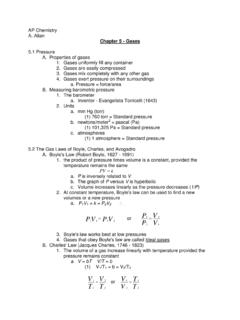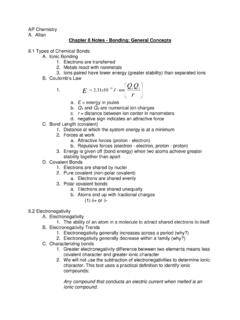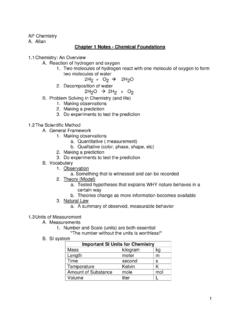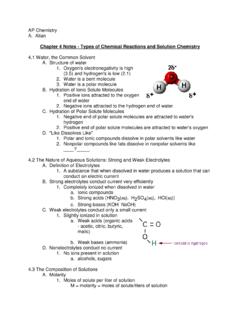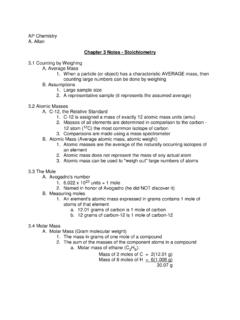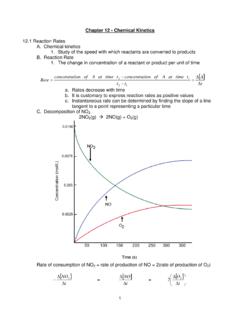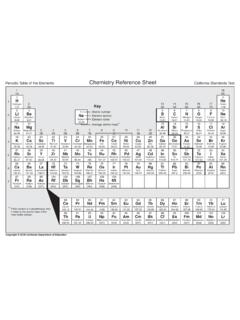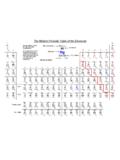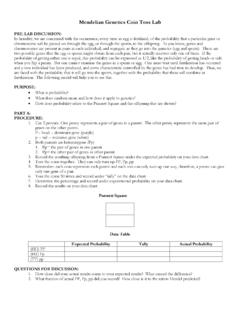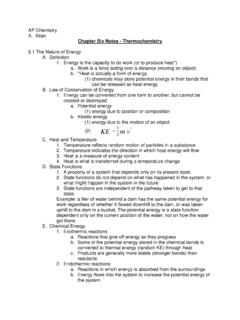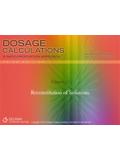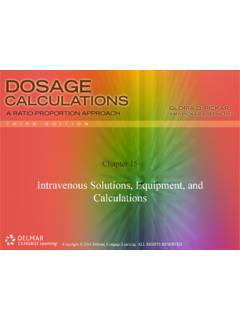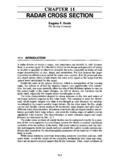Transcription of Chapter 11 – Properties of Solutions
1 1 BAAA nnnxcomponentAoffractionMole+== Chapter 11 Properties of Solutions Solution Composition A. Molarity 1. solutionofliterssolutemolesMMolarity=)( B. Mass Percent 1. 100 =solutionofmasssoluteofmasspercentMass C. Mole Fraction 1. D. Molality 1. solventoframkisoluteofmolesMolalitylog= E. Normality 1. solutionoflitersequivalentNormality= 2. Equivalents of acids and bases a. Mass that donates or accepts a mole of protons 3. Equivalents of oxidizing and reducing agents a. Mass that provides or accepts a mole of electrons The Energies of Solution Formation A. Like Dissolves Like 1. Polar molecules and ionic compounds tend to dissolve in polar solvents 2.
2 Nonpolar molecules dissolve in nonpolar compounds B. Steps of Solution Formation 1. Breaking up the solute into individual components (expanding the solute) a. Endothermic 2. Overcoming intermolecular forces in the solvent to make room for the solute (expanding the solvent) a. Endothermic 3. Allowing the solute and solvent to interact to form the solution a. Often exothermic C. Enthalpy (Heat) of Solution 1. 321'stepstepstepnsolHHHH + + = 2. sol n may have a positive sign or a negative sign 3. Enthalpy (Heat) of Hydration, hyd a. Include of step 2 and step 3 2 D. Factors Favoring the Solution Process 1. Negative value for sol n 2.
3 Increase in entropy 3. For positive values of sol n it is the increase in entropy that outweighs the increase in energy and causes the solution process of occur Factors Affecting Solubility A. Structure Effects 1. Polar (hydrophilic) dissolves in polar a. Water soluble vitamins 2. Nonpolar (hydrophobic) in nonpolar a. Fat soluble vitamins B. Pressure Effects 1. Henry s Law a. The amount of a gas dissolved in a solution is directly proportional to the pressure of the gas above the solution b. P = kC (1) P = partial pressure of the gaseous solute above the solution (2) C = concentration of the dissolved gas (3) k = constant characteristic of a particular solution c.
4 Henry s Law works best for dilute Solutions of gases that do not dissociate or react with the solvent C. Temperature Effects 1. Solids a. Increases in temperature always cause dissolving to occur more rapidly b. Increases in temperature usually increases solubility (the amount that can be dissolved) 2. Gases a. Solubility of gases always decreases with increasing temperature The Vapor Pressure of Solutions A. Nonvolatile Solutes 1. Nonvolatile electrolytes lower the vapor pressure of a solute a. Nonvolatile molecules do not enter the vapor phase b. Fewer molecules are available to enter the vapor phase B. Raoult's Law 1. 0lnsolventsolventsoPXP= where Xsolvent is the mole fraction of the solvent in the solution a.
5 A linear equation (y = mx) 2. Molar mass of a solute can be calculated from experimental results for vapor pressure lowering C. Ionic solutes 1. Dissociation of ionic compounds has nearly two, three or more times the vapor pressure lowering of nonionic (nonelectrolyte) solutes. 3 D. Non-ideal Solutions 1. Liquid-liquid Solutions in which both components are volatile 2. Modified Raoult's Law: 00 BBAABATOTALPXPXPPP+=+= a. P0 is the vapor pressure of the pure solvent b. PA and PB are the partial pressures E. Ideal Solutions 1. Liquid-liquid solution that obeys Raoult's law a. No solution is perfectly ideal, though some are close 2.
6 Negative deviations from Raoult's law (lower than predicted vapor pressure for the solution) a. Solute and solvent are similar, with strong forces of attraction b. Hsol'n is large and negative 3. Positive deviations from Raoult's law (higher than predicted vapor pressure for the solution) a. Solute and solvent are dissimiliar, with only weak forces of attraction b. Particles easily escape attractions in solution to enter the vapor phase Boiling Point Elevation and Freezing-Point Depression A. Colligative Properties 1. Properties dependent on the number of solute particles but not on their identity a. Boiling-Point elevation b. Freezing-Point depression c.
7 Osmotic Pressure B. Boiling-Point Elevation 1. Nonvolatile solutes elevate the boiling point of the solvent solutebmKT= a. is the boiling point elevation b. Kb is the molal boiling point elevation constant of the solvent c. msolute is the molality of the solute in the solution C. Freezing-Point Depression 1. Solutes depress the freezing point of the solvent solutefmKT= a. is the freezing point depression b. Kf is the molal freezing point depression constant of the solvent c. msolute is the molality of the solute in the solution 4 Osmotic Pressure A. Osmosis 1. The flow of solvent molecules into a solution through a semipermeable membrane B.
8 Osmotic Pressure 1. The pressure necessary to keep water from flowing across a semipermeable membrane 2. Osmotic pressure can be used to characterize Solutions and determine molar masses = MRT a. is osmotic pressure in atmospheres b. M is the molarity of the solution c. R is the gas law constant d. T is the Kelvin temperature C. Dialysis 1. Transfer of solvent molecules as well as small solute molecules and ions D. Isotonic Solutions 1. Solutions that have the same osmotic pressure E. Osmotic Pressure and Living Cells 1. Crenation a. Cells placed in a hypertonic solution lose water to the solution, and shrink 2. Hemolysis a. Cells placed in a hypotonic solution gain water from the solution and swell, possibly bursting F.
9 Reverse Osmosis 1. External pressure applied to a solution can cause water to leave the solution a. Concentrates impurities (such as salt) in the remaining solution b. Pure solvent (such as water) is recovered on the other side of the semipermeable membrane 5 Colligative Properties of Electrolyte Solutions A. van't Hoff factor i: 1. dissolvedsoluteofmolessolutioninparticle sofmolesi= 2. For ionic compounds, the expected value of i is an integer greater than 1 a. NaCl, i = 2 b. BaCl2, i = 3 c. Al2(SO4)3, i = 5 B. Actual values of i 1. Values of i are less than expected due to ion pairing (clustering) 2. Refer to 3. Values of i are closer to the expected the more dilute the solution becomes C.
10 Incorporation of van't Hoff factor in Problem Solving 1. Boiling-elevation and freezing-point depression a. T = imK 2. Osmotic pressure a. = iMRT Colloids A. Colloidal Dispersions (Colloids) 1. Tiny particles suspended in some medium 2. Particles range in size from 1 to 1000 nm. B. Tyndall Effect 1. Scattering of light by particles a. Light passes through a solution b. Light is scattered in a colloid Table Types of Colloids Examples Dispersing Medium Dispersed Substance Colloid Type Fog, aerosol sprays Gas Liquid Aerosol Smoke, airborne bacteria Gas Solid Aerosol Whipped cream, soap suds Liquid Gas Foam Milk, mayonnaise Liquid Liquid Emulsion Paint, clays, gelatin Liquid Solid Sol Marshmallow, polystyrene foam Solid Gas Solid foam Butter, cheese Solid Liquid Solid emulsion Ruby glass Solid Solid Solid sol
